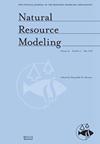当以旅游为基础的社会生态系统的承载能力发生变化时,可能会出现灾难性或可持续的情景
IF 2.1
4区 环境科学与生态学
Q3 ENVIRONMENTAL SCIENCES
引用次数: 0
摘要
在这项工作中,我们提出了一个社会生态模型来描述游客对生物景点的影响。我们模拟了森林资源和野生动物与游客之间的条件相互作用。这使我们能够描述该物种及其栖息地从与游客的互动中获得的净收益-成本率。我们表明,当可持续旅游的情景存在时,它总是处于危险之中。这是因为当初始条件属于边界平衡的吸引力盆地时,至少有一个社会生态系统的组成部分可以归零。然而,当初始条件属于正吸引子的吸引盆地时,可以达到可持续的平衡。模型分析表明,旅游承载力的增加会导致不同的动态格局。有时,这些模式描述了不可持续旅游业的情景。在这种情况下,通过减少自然和野生动物旅游业的负面影响,可以达到旅游业的可持续性。在旅游业不可持续的情景中,有没有野生动物和/或游客或两者都没有的情景;生态和社会变量显示持续振荡的情景,或这些变量具有混乱模式的情景。本文给出了模型的数值解,以显示不同情景下旅游承载力的变化情况。本文章由计算机程序翻译,如有差异,请以英文原文为准。
Catastrophic or sustainable scenarios might occur when the carrying capacities of a tourism‐based socioecological system vary
In this work, we propose a socioecological model to describe the effects of visiting tourists in biological attractive sites. We model conditioned interactions between the forest resources and the wildlife with the tourists. This allows us to describe the net benefits–costs rates that the species and their habitats receive from the interaction with tourists. We show that when a scenario of sustainable tourism exists, it is always at risk. This occurs because there is at least a component of the socioecological system that can go to zero when the initial conditions belong to the basin of attraction of a border equilibrium. However, a sustainable equilibrium can be reached when the initial conditions belong to the basin of attraction of a positive attractor. The analysis of the model shows that increasing the tourism carrying capacities can lead to different dynamical patterns. Sometimes, these patterns describe scenarios of unsustainable tourism. When this is the case, by decreasing the negative impact due to the nature and wildlife‐based tourism industry, a tourism sustainability can be reached. Among the scenarios of unsustainable tourism, there are scenarios without wildlife and/or tourists or without both; scenarios in which the ecological and the social variable show sustained oscillations, or scenarios with chaotic patterns for these variables. We show numerical solutions of the model to display different scenarios when the touristic carrying capacities are varied.
求助全文
通过发布文献求助,成功后即可免费获取论文全文。
去求助
来源期刊

Natural Resource Modeling
环境科学-环境科学
CiteScore
3.50
自引率
6.20%
发文量
28
审稿时长
>36 weeks
期刊介绍:
Natural Resource Modeling is an international journal devoted to mathematical modeling of natural resource systems. It reflects the conceptual and methodological core that is common to model building throughout disciplines including such fields as forestry, fisheries, economics and ecology. This core draws upon the analytical and methodological apparatus of mathematics, statistics, and scientific computing.
 求助内容:
求助内容: 应助结果提醒方式:
应助结果提醒方式:


